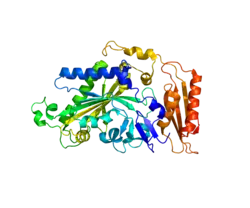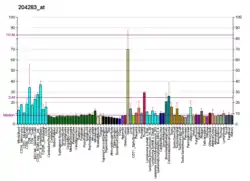FARS2
Phenylalanyl-tRNA synthetase, mitochondrial (FARS2) is an enzyme that in humans is encoded by the FARS2 gene.[5] This protein encoded by FARS2 localizes to the mitochondrion and plays a role in mitochondrial protein translation. Mutations in this gene have been associated with combined oxidative phosphorylation deficiency 14, also known as Alpers encephalopathy, as well as spastic paraplegia 77 and infantile-onset epilepsy and cytochrome c oxidase deficiency.[6][7]
| FARS2 | |||||||||||||||||||||||||||||||||||||||||||||||||||
|---|---|---|---|---|---|---|---|---|---|---|---|---|---|---|---|---|---|---|---|---|---|---|---|---|---|---|---|---|---|---|---|---|---|---|---|---|---|---|---|---|---|---|---|---|---|---|---|---|---|---|---|
 | |||||||||||||||||||||||||||||||||||||||||||||||||||
| |||||||||||||||||||||||||||||||||||||||||||||||||||
| Identifiers | |||||||||||||||||||||||||||||||||||||||||||||||||||
| Aliases | FARS2, COXPD14, FARS1, HSPC320, PheRS, dJ520B18.2, phenylalanyl-tRNA synthetase 2, mitochondrial, SPG77, mtPheRS | ||||||||||||||||||||||||||||||||||||||||||||||||||
| External IDs | OMIM: 611592 MGI: 1917205 HomoloGene: 4788 GeneCards: FARS2 | ||||||||||||||||||||||||||||||||||||||||||||||||||
| |||||||||||||||||||||||||||||||||||||||||||||||||||
| |||||||||||||||||||||||||||||||||||||||||||||||||||
| |||||||||||||||||||||||||||||||||||||||||||||||||||
| |||||||||||||||||||||||||||||||||||||||||||||||||||
| |||||||||||||||||||||||||||||||||||||||||||||||||||
| Wikidata | |||||||||||||||||||||||||||||||||||||||||||||||||||
| |||||||||||||||||||||||||||||||||||||||||||||||||||
Structure
FARS2 is located on the p arm of chromosome 6 in position 25.1 and has 15 exons.[6] This gene encodes a member of the class-II aminoacyl-tRNA synthetase family.[8][9] FARS2 is a phenylalanine-tRNA synthetase (PheRS) localized to the mitochondrion which consists of a single polypeptide chain, unlike the (alpha-beta)2 structure of the prokaryotic and eukaryotic cytoplasmic forms of PheRS. Structure analysis and catalytic properties indicate mitochondrial PheRSs may constitute a class of PheRS distinct from the enzymes found in prokaryotes and in the eukaryotic cytoplasm.[6]
Function
Aminoacyl-tRNA synthetases are a class of enzymes that charge tRNAs with their cognate amino acids.[6] FARS2 charges tRNA(Phe) with phenylalanine and catalyzes direct attachment of m-Tyr (an oxidized version of Phe) to tRNA(Phe). This makes it important for mitochondrial translation and for delivery of the misacylated tRNA to the ribosome and incorporation of ROS-damaged amino acid into proteins.[8][9][10][11] Alternative splicing results in multiple transcript variants.[6]
Catalytic activity
ATP + L-phenylalanine + tRNA(Phe) = AMP + diphosphate + L-phenylalanyl-tRNA(Phe)[8][9][10][11]
Clinical significance
Mutations in FARS2 have been associated to combined oxidative phosphorylation deficiency 14, spastic paraplegia 77, and infantile-onset epilepsy and cytochrome c oxidase deficiency. Both combined oxidative phosphorylation deficiency 14 and spastic paraplegia 77 are autosomal recessive in nature and have been linked to several pathogenic variants including Y144C,[12] I329T, D391V,[11] and D142Y.[13] Combined oxidative phosphorylation deficiency 14 is characterized by neonatal onset of global developmental delay, refractory seizures, lactic acidosis, and deficiencies of multiple mitochondrial respiratory enzymes. Spastic paraplegia, meanwhile, is a neurodegenerative disorder characterized by a slow, gradual, progressive weakness and spasticity of the lower limbs, with patients often exhibiting difficulty with balance, weakness and stiffness in the legs, muscle spasms, and dragging the toes when walking.[8][9] One case of infantile-onset epilepsy and cytochrome c oxidase deficiency resulting from a FARS2 Asp325Tyr missense mutation has also been reported. Early-onset epilepsy, neurological deficits, and complex IV deficiency are the main characteristics of the disease stemming from this mutation.[7]
Interactions
FARS2 has been shown to have 193 binary protein-protein interactions including 12 co-complex interactions. FARS2 appears to interact with RCBTB2, KRTAP10-9, CALCOCO2, KRT40, MID2, APPL1, IKZF3, KRT13, TADA2A, STX11, TRIM27, KRTAP10-5, KRTAP10-7, TFCP2, MKRN3, KRT31, HMBOX1, AGTRAP, ADAMTSL4, NOTCH2NL, CMTM5, TRIM54, FSD2, CYSRT1, HIGD1C, homez, SPRY1, ZNF500, KRT34, YIF1A, BAG4, TPM2, SYP, KRTAP10-8, KRTAP1-1, AP1B1, TRAF2, GRB10, MESD, TRIP6, CCDC152, BEX5, FHL5, MORN3, DGAT2L6, ZNF438, KCTD17, ZNF655, BANP, SPERT, NFKBID, ZNF526, PCSK5, DVL3, AJUBA, PPP1R16B, MDFI, DPH2, CDCA4, KRTAP3-3, BACH2, KCNF1, MAN1C1, RIMBP3, ZRANB1, ISY1, FKBP7, and E7.[14]
References
- GRCh38: Ensembl release 89: ENSG00000145982 - Ensembl, May 2017
- GRCm38: Ensembl release 89: ENSMUSG00000021420 - Ensembl, May 2017
- "Human PubMed Reference:". National Center for Biotechnology Information, U.S. National Library of Medicine.
- "Mouse PubMed Reference:". National Center for Biotechnology Information, U.S. National Library of Medicine.
- Bullard JM, Cai YC, Demeler B, Spremulli LL (May 1999). "Expression and characterization of a human mitochondrial phenylalanyl-tRNA synthetase". Journal of Molecular Biology. 288 (4): 567–77. doi:10.1006/jmbi.1999.2708. PMID 10329163.
- "Entrez Gene: FARS2 phenylalanyl-tRNA synthetase 2, mitochondrial".
 This article incorporates text from this source, which is in the public domain.
This article incorporates text from this source, which is in the public domain. - Almalki A, Alston CL, Parker A, Simonic I, Mehta SG, He L, Reza M, Oliveira JM, Lightowlers RN, McFarland R, Taylor RW, Chrzanowska-Lightowlers ZM (January 2014). "Mutation of the human mitochondrial phenylalanine-tRNA synthetase causes infantile-onset epilepsy and cytochrome c oxidase deficiency". Biochimica et Biophysica Acta (BBA) - Molecular Basis of Disease. 1842 (1): 56–64. doi:10.1016/j.bbadis.2013.10.008. PMC 3898479. PMID 24161539.
- "FARS2 - Phenylalanine--tRNA ligase, mitochondrial precursor - Homo sapiens (Human) - FARS2 gene & protein". www.uniprot.org. Retrieved 2018-09-05.
 This article incorporates text available under the CC BY 4.0 license.
This article incorporates text available under the CC BY 4.0 license. - "UniProt: the universal protein knowledgebase". Nucleic Acids Research. 45 (D1): D158–D169. January 2017. doi:10.1093/nar/gkw1099. PMC 5210571. PMID 27899622.
- Klipcan L, Moor N, Kessler N, Safro MG (July 2009). "Eukaryotic cytosolic and mitochondrial phenylalanyl-tRNA synthetases catalyze the charging of tRNA with the meta-tyrosine". Proceedings of the National Academy of Sciences of the United States of America. 106 (27): 11045–8. Bibcode:2009PNAS..10611045K. doi:10.1073/pnas.0905212106. PMC 2700156. PMID 19549855.
- Elo JM, Yadavalli SS, Euro L, Isohanni P, Götz A, Carroll CJ, Valanne L, Alkuraya FS, Uusimaa J, Paetau A, Caruso EM, Pihko H, Ibba M, Tyynismaa H, Suomalainen A (October 2012). "Mitochondrial phenylalanyl-tRNA synthetase mutations underlie fatal infantile Alpers encephalopathy". Human Molecular Genetics. 21 (20): 4521–9. doi:10.1093/hmg/dds294. PMID 22833457.
- Shamseldin HE, Alshammari M, Al-Sheddi T, Salih MA, Alkhalidi H, Kentab A, Repetto GM, Hashem M, Alkuraya FS (April 2012). "Genomic analysis of mitochondrial diseases in a consanguineous population reveals novel candidate disease genes". Journal of Medical Genetics. 49 (4): 234–41. doi:10.1136/jmedgenet-2012-100836. PMID 22499341. S2CID 5856138.
- Yang Y, Liu W, Fang Z, Shi J, Che F, He C, Yao L, Wang E, Wu Y (February 2016). "A Newly Identified Missense Mutation in FARS2 Causes Autosomal-Recessive Spastic Paraplegia". Human Mutation. 37 (2): 165–9. doi:10.1002/humu.22930. PMID 26553276. S2CID 46241711.
- "193 binary interactions found for search term FARS2". IntAct Molecular Interaction Database. EMBL-EBI. Retrieved 2018-09-05.
Further reading
- Levin I, Kessler N, Moor N, Klipcan L, Koc E, Templeton P, Spremulli L, Safro M (September 2007). "Purification, crystallization and preliminary X-ray characterization of a human mitochondrial phenylalanyl-tRNA synthetase". Acta Crystallographica Section F. 63 (Pt 9): 761–4. doi:10.1107/S1744309107038651. PMC 2376306. PMID 17768348.
- Brandenberger R, Wei H, Zhang S, Lei S, Murage J, Fisk GJ, Li Y, Xu C, Fang R, Guegler K, Rao MS, Mandalam R, Lebkowski J, Stanton LW (June 2004). "Transcriptome characterization elucidates signaling networks that control human ES cell growth and differentiation". Nature Biotechnology. 22 (6): 707–16. doi:10.1038/nbt971. PMID 15146197. S2CID 27764390.
- Harrington JJ, Sherf B, Rundlett S, Jackson PD, Perry R, Cain S, Leventhal C, Thornton M, Ramachandran R, Whittington J, Lerner L, Costanzo D, McElligott K, Boozer S, Mays R, Smith E, Veloso N, Klika A, Hess J, Cothren K, Lo K, Offenbacher J, Danzig J, Ducar M (May 2001). "Creation of genome-wide protein expression libraries using random activation of gene expression". Nature Biotechnology. 19 (5): 440–5. doi:10.1038/88107. PMID 11329013. S2CID 25064683.
- Suzuki Y, Yoshitomo-Nakagawa K, Maruyama K, Suyama A, Sugano S (October 1997). "Construction and characterization of a full length-enriched and a 5'-end-enriched cDNA library". Gene. 200 (1–2): 149–56. doi:10.1016/S0378-1119(97)00411-3. PMID 9373149.
- Maruyama K, Sugano S (January 1994). "Oligo-capping: a simple method to replace the cap structure of eukaryotic mRNAs with oligoribonucleotides". Gene. 138 (1–2): 171–4. doi:10.1016/0378-1119(94)90802-8. PMID 8125298.
External links
- Nuclear Gene-Encoded Leigh Syndrome Overview
- Mitochondrial DNA-Associated Leigh Syndrome and NARP
- Overview of all the structural information available in the PDB for UniProt: O95363 (Phenylalanine--tRNA ligase, mitochondrial) at the PDBe-KB.
This article incorporates text from the United States National Library of Medicine, which is in the public domain.





